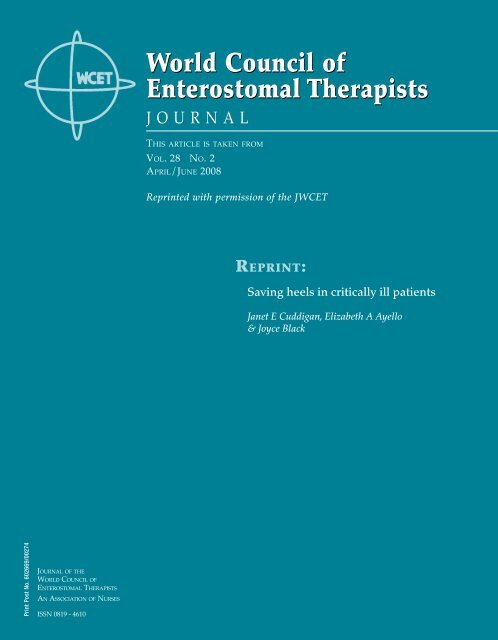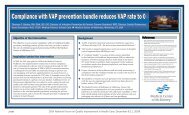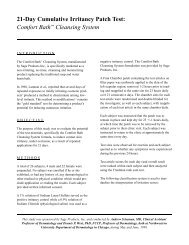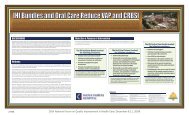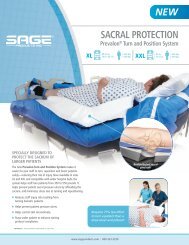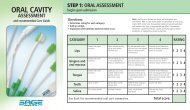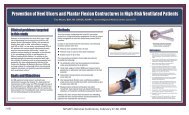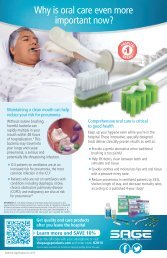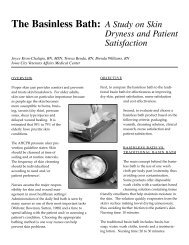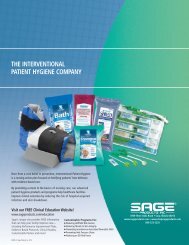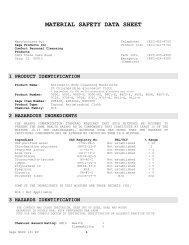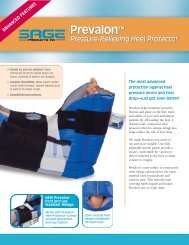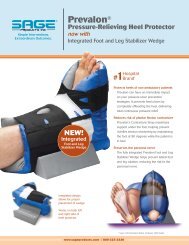Saving Heels in Critically Ill Patients - Sage Products Inc.
Saving Heels in Critically Ill Patients - Sage Products Inc.
Saving Heels in Critically Ill Patients - Sage Products Inc.
You also want an ePaper? Increase the reach of your titles
YUMPU automatically turns print PDFs into web optimized ePapers that Google loves.
World Council ofEnterostomal TherapistsJ o u r n a lThis article is taken fromVol. 28 No. 2April/June 2008Repr<strong>in</strong>ted with permission of the JWCETRepr<strong>in</strong>t:<strong>Sav<strong>in</strong>g</strong> heels <strong>in</strong> critically ill patientsJanet E Cuddigan, Elizabeth A Ayello& Joyce BlackPr<strong>in</strong>t Post No. 602669/00274Journal of theWorld Council ofEnterostomal TherapistsAn Association of NursesISSN 0819 - 4610www.wcetn.org1
<strong>Sav<strong>in</strong>g</strong> heels <strong>in</strong> critically ill patientsJanet E CuddiganPhD, RN, CWCN, CCCNAssistant Professor & Chair, Adult Health and <strong>Ill</strong>ness DeptUniversity of Nebraska Medical CenterCollege of Nurs<strong>in</strong>g, Omaha, Nebraska, USAElizabeth A AyelloPhD, RN, ACNS-BC, ETN, FAPWCA, FAANFaculty, Excelsior College of Nurs<strong>in</strong>g, Albany, New YorkSenior Advisor, The John A Harford Institute for GeriatricNurs<strong>in</strong>g, New York, NY, USAJoyce BlackPhD, RN, CWCN, CPSNAssociate Professor, University of Nebraska Medical CenterCollege of Nurs<strong>in</strong>g, Omaha, Nebraska, USAAbstractHeel ulcers are an <strong>in</strong>creas<strong>in</strong>g nosocomial healthcare problem <strong>in</strong>critically ill patients. Because of the economic costs and patientmorbidity, medical organisations concerned with quality of carehave established guidel<strong>in</strong>es and recommendations for report<strong>in</strong>gand prevent<strong>in</strong>g pressure ulcers. In October 2008, Medicaid andMedicare will no longer reimburse acute care hospitals <strong>in</strong> theUSA at a higher rate for costs associated with the care of pressureulcers that develop dur<strong>in</strong>g hospitalisation.A quick, easy, <strong>in</strong>tuitive, effective, evidence-based algorithm forthe prevention of heel pressure ulcers is presented. It requiresfive steps that <strong>in</strong>clude assessment of patient risks for heel ulcerdevelopment and <strong>in</strong>terventions to protect the ‘at-risk’ heel. Inaddition, a model for identify<strong>in</strong>g and prevent<strong>in</strong>g Achilles tendoncontracture (foot drop) is presented as part of the overall care planfor the critically ill patient who is at risk for heel ulcers.The Scope of the Problem of Pressure UlcersPressure ulcers are common <strong>in</strong> the acute and long-termhealthcare sett<strong>in</strong>g worldwide. <strong>Heels</strong> are the second mostcommon site of pressure ulcers, with the sacrum be<strong>in</strong>g the first.Prevalence rates for all pressure ulcers range from 4.94-25.1% <strong>in</strong>the acute care sett<strong>in</strong>g 1, 2 . In the US, the National Pressure UlcerAdvisory Panel (NPUAP) reported that the average <strong>in</strong>cidenceof pressure ulcers <strong>in</strong> hospitals is 7% 3 . Of these, about 30% areheel ulcers 4 . There is evidence that the frequency of pressureulceration is <strong>in</strong>creas<strong>in</strong>g. Between 1993 and 2003, there was a63% <strong>in</strong>crease <strong>in</strong> the number of US hospital stays dur<strong>in</strong>g whichpressure ulcers were noted 5 .The costs associated with <strong>in</strong>cident pressure ulcers areconsiderable. In a tertiary teach<strong>in</strong>g hospital, hip fracture patientswho developed pressure ulcers had a mean unadjusted hospitalcost of US$37,288 compared to $13,924 for those who did not 6 .Costs of care for a pressure ulcer have been estimated to be ashigh as $70,000 for a complex full-thickness ulcer 7 . National costs<strong>in</strong> the US per year are estimated at $11 billion per year 8 . Drennanhas proposed a simple formula to estimate costs related to heelpressure ulcers: numbers of heel ulcers × cost per ulcer (wherethe number of heel ulcers can be estimated as the number ofhospital discharges × % acquired pressure ulcer prevalence × %heel ulcers) 9 .Some of the <strong>in</strong>creased cost may be due to an <strong>in</strong>creased length ofhospital stay for those with pressure ulcers. In 2005, the averagelength of stay (LOS) for hospitalised patients <strong>in</strong> the US was 4.6days 10 . Dur<strong>in</strong>g the 11 year period from 1993-2003, the meanLOS for primary treatment of pressure ulcers was 13 days, butLOS varied by patient age 5 . In patients with hip fractures, themean LOS was 12.8 days for those without pressure ulcers and30.4 days for those who developed pressure ulcers 6 . In a groupof patients aged 18 and older, hav<strong>in</strong>g a pressure ulcer led to amedian excess LOS of 4.31 days 11 .In the US, the Institute for Healthcare Improvement (IHI)has made prevention of pressure ulcers part of its 5 MillionLives Campaign to reduce harm to hospitalised patients (www.IHI.org) 13 . This IHI <strong>in</strong>itiative builds on the success of the100,000 Lives Campaign by add<strong>in</strong>g pressure ulcers as one ofsix additional <strong>in</strong>terventions. The goal is to reduce the <strong>in</strong>cidenceof hospital-acquired pressure ulcers to zero by December 2008.IHI has several resources available to assist nurses <strong>in</strong> theirefforts to reduce pressure ulcers. This <strong>in</strong>cludes a “How-to Guide”to prevent pressure ulcers which is available on their website(available at http://www.ihi.org/nr/rdonlyres/5ababb51-93b3-4d88-ae19-be88b7d96858/0/pressureulcerhowtoguide.doc).Key strategies to reduce pressure ulcers can be found <strong>in</strong> Table1. Two key components to m<strong>in</strong>imis<strong>in</strong>g pressure <strong>in</strong>clude turn<strong>in</strong>gand reposition<strong>in</strong>g at-risk patients every 2 hours to reduce orelim<strong>in</strong>ate pressure 12 . Pillows and blankets may be used to assist<strong>in</strong> pressure reduction. Use the pillows under the calf to elevatethe patient’s heels off the bed surface and use cushion<strong>in</strong>g devicesbetween the legs and ankles to ma<strong>in</strong>ta<strong>in</strong> alignment and preventpressure on bony prom<strong>in</strong>ences. Specialised support surfacescan also be used to redistribute pressure over a greater area,thus reduc<strong>in</strong>g the amount of pressure over any one pressurepo<strong>in</strong>t. Use lift devices or drawsheets to move a patient, and tom<strong>in</strong>imise friction aga<strong>in</strong>st sk<strong>in</strong> over bony prom<strong>in</strong>ences 13 .Pressure ulcers are viewed as an <strong>in</strong>dicator of the quality ofhealthcare and, as such, are a focus of attention <strong>in</strong> recentchanges <strong>in</strong> state and federal regulations. As a signal of changesWCET Journal April/June 2008, 28(2)2
to come, one US state requires a report with<strong>in</strong> 3 work<strong>in</strong>gdays of any stage III or IV pressure ulcers that develop dur<strong>in</strong>ghospitalisation (not <strong>in</strong>clud<strong>in</strong>g patients with a stage II ulcer atadmission that progresses) 14 . Federal regulatory changes willprofoundly affect reimbursement. Start<strong>in</strong>g <strong>in</strong> October 2008,the Centers for Medicare and Medicaid Services (CMS) will nolonger reimburse providers at a higher rate for care of pressureulcers that develop while a patient is <strong>in</strong> the acute care hospital 15 .Prevention<strong>Critically</strong> ill patients are at particular risk for pressure ulcers andprevention should be geared toward identify<strong>in</strong>g and address<strong>in</strong>gthose risks. <strong>Patients</strong> <strong>in</strong> critical care units typically score poorlyon general risk assessment tools such as the Braden, Norton,and Waterlow scales, and have a high <strong>in</strong>cidence of risk factorsspecific to heel ulceration. Impaired oxygenation and perfusionrender them even more vulnerable to the ischaemic effects ofpressure 3 .Interventions to improve oxygenation and perfusion alreadyform the core of critical care practice. Preventive strategies mustalso address the risk factors identified by the subscales of theBraden scale, i.e. sensory perception, mobility, activity, moisture,nutrition, and friction and shear (see www.bradenscale.com).Epidemiological studies have identified additional risk factorsconsidered unique to the critical care population, e.g. useof vasopressors, comorbid conditions, severity of illness asmeasured by the APACHE scale, hypotension, or be<strong>in</strong>g toounstable to turn.Several <strong>in</strong>vestigators have developed a pressure ulcer riskassessment tool for critical care. However, follow<strong>in</strong>g a systematicreview of this body of literature, De Laat and colleagues reportedmixed results and concluded that there was no one specific riskfactor that was consistently valid and discrim<strong>in</strong>atory for thispopulation 16 . The most effective assessment of pressure ulcerrisk blends the results of general screen<strong>in</strong>g tools, such as theBraden scale, knowledge of <strong>in</strong>dividual risk factors common tothe patient population, and nurs<strong>in</strong>g judgment.Due to the special needs of critically ill patients, Blaszczykand colleagues (1998) developed a Heel Pressure Ulcer RiskTable 1. IHI Key <strong>in</strong>terventions for prevent<strong>in</strong>g pressure ulcers.• Conduct a pressure ulcer admission assessment for allpatients.• Reassess risk for all hospitalised patients daily.• Inspect sk<strong>in</strong> daily.• Manage moisture: keep the patient dry and moisturisethe sk<strong>in</strong>.• Optimise nutrition and hydration.• M<strong>in</strong>imise pressure with reposition<strong>in</strong>g and supportsurfaces designed to redistribute pressure.Assessment tool (HPURAT) from their medical <strong>in</strong>tensivecare unit (MICU) prevalence data, patient demographics, andpressure ulcer risk scales 17 . By identify<strong>in</strong>g patients at risk forheel pressure ulcers and rigorously adher<strong>in</strong>g to a risk stratifiedprotocol, they were able to decrease pressure ulcers of the heels.A number of strategies have been suggested to prevent pressureulcers. These typically <strong>in</strong>clude early patient mobilisation, correctpatient position<strong>in</strong>g on the bed or chair, and off-load<strong>in</strong>g pressuresites. Black suggests <strong>in</strong>terventions for patients with low Bradenscores to reduce the risks of heel ulcers 18 . These <strong>in</strong>terventions<strong>in</strong>clude elevat<strong>in</strong>g the heel and avoid<strong>in</strong>g hyperextension at theknee for patients with immobilised lower extremities 18 . The bestdevice is one that reduces pressure, friction, and shear; ma<strong>in</strong>ta<strong>in</strong>sheel suspension; prevents foot drop; and is comfortable and easyto use 18 .The use of an assessment tool, like the Braden scale, to identifyhigh risk patients, comb<strong>in</strong>ed with use of pressure-reliev<strong>in</strong>g heelboots, has proven effective <strong>in</strong> reduc<strong>in</strong>g heel ulceration rates.Walsh and colleagues found that patients with a Braden risk scoreof 16 or less, or patients with a score of 17-18 and any additionalrisk factor, benefitted from the use of pressure-reliev<strong>in</strong>g heelelevator boots. <strong>Patients</strong> <strong>in</strong> these risk groups who were givenbilateral heel pressure-reliev<strong>in</strong>g devices had significantly fewerheel ulcers than the control group (χ 2 =86.37/p
the admitt<strong>in</strong>g nurse ends his/her shift. Assessment protocolscan be found at www.bradenscale.com and <strong>in</strong> the Try This series:Predict<strong>in</strong>g Pressure Ulcer (for the Hartford Institute for GeriatricNurs<strong>in</strong>g) at www.ConsultGeriRN.orgSpecial attention should be given to the specific risks associatedwith heel pressure ulceration:• Indications of poor perfusion, <strong>in</strong>clud<strong>in</strong>g a history ofperipheral vascular disease, an ankle-brachial <strong>in</strong>dex of lessthan 0.75, a history of diabetes with circulatory impairment,current treatment with vasopressors, or feet that are coolto the touch and have weak or absent pulses at the foot orankle.• The presence of leg immobility and/or impaired sensationfrom neuropathy, sedation, paralytic medication use, coma,shock, sp<strong>in</strong>al cord <strong>in</strong>jury, stroke, or fracture of the hip orlower extremity.• The presence of factors that <strong>in</strong>crease friction or shear forcesaga<strong>in</strong>st the heel, <strong>in</strong>clud<strong>in</strong>g leg spasms or motor agitation.Step 3: Determ<strong>in</strong>e anticipated time of immobilityThe development of pressure ulcers is strongly associated withthe <strong>in</strong>tensity and duration of immobility 30 . Because of this, thechoice of prevention strategies will be partly determ<strong>in</strong>ed bythe amount of time the patient will be immobile. If conditionsare present that are likely to lead to long-term immobility(≥6 hours), then bilateral heel-suspension devices should beconsidered as part of the ‘bundle’ of preventive care measurestypically done for such patients (e.g. ventilator bundle). If thetime of immobility is difficult to estimate, approach the patientas if they will have short-term immobility, and then reassess thepatient <strong>in</strong> 6 hours.Short-term immobility <strong>in</strong>terventions should <strong>in</strong>clude placementof pillows under the length of both calves to completely suspendboth heels as an <strong>in</strong>expensive, short-term <strong>in</strong>tervention. Examplesof patients who might require care for short-term mobility<strong>in</strong>clude those recover<strong>in</strong>g from anaesthesia or short-termsedation. These patients should be reassessed after 6 hours andmoved to long-term <strong>in</strong>tervention if they rema<strong>in</strong> immobile.Long-term immobility <strong>in</strong>terventions should be <strong>in</strong>stituted ifthe patient will be or has been immobile for 6 or more hours.<strong>Patients</strong> <strong>in</strong> this category <strong>in</strong>clude (but are not limited to)those who are ventilator-dependent, sedated, immobilisedby paralytics, <strong>in</strong> a coma, <strong>in</strong> shock, <strong>in</strong> traction await<strong>in</strong>g hipsurgery post fracture, or immobilised by a sp<strong>in</strong>al cord <strong>in</strong>juryor other trauma. Because a longer period of immobilityis anticipated, these patients require more aggressivepreventive management. The choice of preventive measuresis determ<strong>in</strong>ed <strong>in</strong> response to additional assessments of legand foot movement, sk<strong>in</strong> assessment, the presence of footdrop due to shorten<strong>in</strong>g of the Achilles tendon (Figure 2), andon-go<strong>in</strong>g risks. As noted previously, the <strong>in</strong>stitution may wishto make heel-suspension devices an automatic part of ‘bundles’or services that are usually delivered together. For example,a patient on a ventilator will require mouth care products toprevent ventilator associate pneumonia, suction catheters, andheel-suspension devices due to immobility.Step 4: Intervene to save heels – based on amount of leg andfoot movementFriction between the heel and the bed, l<strong>in</strong>ens, or other materialscan cause direct tissue <strong>in</strong>jury. Friction of the heels is commonlyseen <strong>in</strong> confused or agitated patients and patients <strong>in</strong> pa<strong>in</strong> asthey move their legs <strong>in</strong> bed, abrad<strong>in</strong>g the heels on the l<strong>in</strong>en.Heel friction can also occur with any immobilised patient, andcan result from th<strong>in</strong>gs as simple as pull<strong>in</strong>g the patient up <strong>in</strong>bed if the heels drag. Lift<strong>in</strong>g and turn<strong>in</strong>g the patient with a turnsheet may help reduce friction generated dur<strong>in</strong>g turn<strong>in</strong>g andreposition<strong>in</strong>g.<strong>Patients</strong> with periods of agitation or spasticity are particularlyprone to friction <strong>in</strong>jury. Bots and colleagues found the use ofself-adhesive hydropolymer foam dress<strong>in</strong>gs led to a nearly77% reduction <strong>in</strong> heel ulcer formation <strong>in</strong> surgical patients 31 .Nakagami and fellow <strong>in</strong>vestigators found that shear forceswere reduced with the use of low friction dress<strong>in</strong>gs, but thatthe use of such dress<strong>in</strong>gs alone did not substitute for the use ofheel elevation <strong>in</strong> immobile patients 32 . Although there is a lackof published studies, the use of low friction topical agents (e.g.sk<strong>in</strong> sealants, protective barriers, dimethicone conta<strong>in</strong><strong>in</strong>g topicalagents) may also reduce friction.With regard to leg and/or foot movement, if there is nomovement, then ensure cont<strong>in</strong>uous suspension of the heels andprevention of heel cord shorten<strong>in</strong>g. Dur<strong>in</strong>g the first 24 hours,heel suspension with pillows under the length of the calves isoften adequate.Assess the patient <strong>in</strong> order to prevent foot drop from immobility(Figure 3). Foot drop can be def<strong>in</strong>ed as a significant weaknessof ankle and foot dorsiflexion. However, the term ‘foot drop’ isa simple name for a complex problem. Foot drop can occur forseveral reasons – as a result of central nervous system diseaseor <strong>in</strong>jury, sp<strong>in</strong>al cord disease or <strong>in</strong>jury, damage to the peronealnerve (seen follow<strong>in</strong>g orthopedic trauma to the lower leg andsometimes follow<strong>in</strong>g knee replacement surgery), myopathy dueto critical illness, or immobility that causes shorten<strong>in</strong>g of theFigure 2. Anatomical picture of foot.www.wcetn.org5


